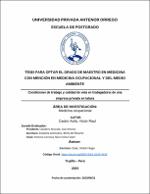| dc.contributor.advisor | Bardales Zuta, Victor Hugo | |
| dc.contributor.author | Castro Avila, Victor Raul | |
| dc.creator | Castro Avila, Victor Raul | |
| dc.date.accessioned | 2023-08-25T14:31:43Z | |
| dc.date.available | 2023-08-25T14:31:43Z | |
| dc.date.issued | 2023 | |
| dc.identifier.uri | https://hdl.handle.net/20.500.12759/11073 | |
| dc.description.abstract | La restricción del crecimiento intrauterino representa una importante
morbimortalidad perinatal y cuya detección es variable según modelos clínicos y
características propias en cada población. OBJETIVO: Evaluar si el Doppler de arterias
uterinas y la edad materna conforman un modelo clínico con capacidad predictiva de
restricción del crecimiento intrauterino en una amplia muestra de población peruana.
MATERIALES Y MÉTODOS: Estudio observacional, analítico, de prueba diagnóstica.
Participaron 1344 gestantes atendidas en un centro de referencia nacional materno perinatal
Nivel III en Perú entre 2010-2018. La muestra fue seleccionada aleatoriamente y dividida en:
muestra de entrenamiento y muestra para validación del mejor modelo clínico obtenido. Se
usó análisis multivariado, medición de la capacidad diagnóstica y predictiva.
RESULTADOS: El modelo clínico formado por el índice de pulsatilidad promedio mayor al
percentil 95 de la arteria uterina y la edad materna mayor a 35 años conformo el modelo con
el menor indicador de penalidad de Akaike en comparación con los otros modelos clínicos
elaborados en el presente estudio, el índice de Youden fue 0.53. El área bajo la curva ROC
fue de 0.75. Se obtuvo una sensibilidad de 71.5%, especificidad 72.1%, valor predictivo
positivo 65.8%, valor predictivo negativo 91.2%. CONCLUSIONES: El uso del índice de
pulsatilidad promedio de la arteria uterina asociado a la edad materna contribuyen a la
formación de un modelo para discriminar RCIU; sin embargo, requiere de otros factores que
permitan ajustar el modelo para una mayor tasa de detección. | es_PE |
| dc.description.abstract | The objective of this research work is to determine the working conditions and quality of life in workers of a private company at the Talara refinery, 2021.
This is an observational, descriptive, prospective and cross-sectional study, which will include all workers from both the operational part and the administrative part and two instruments will be used: the Salazar y Bernabé -SF-36 health questionnaire and the Health Questionnaire. Working Conditions, Safety and Health CENSOPAS-INS. For the statistical analysis, descriptive statistics, student's t-test, and analysis of variance (ANOVA) will be used to compare the demographic and occupational characteristics according to quality of life.
For data processing, the statistical program SPSS V 25 (IBM CORP., NY.USA) will be used. In this system, the database will be created with the information collected in both surveys and the statistical analysis will be carried out as described below. The qualitative variables will be expressed through absolute and relative frequencies. Quantitative variables will be categorized into levels described in the operationalization of variables and will also be expressed through absolute and relative frequencies. To compare the quality of life according to the demographic and occupational characteristics of health personnel, the student's t test and analysis of variance (ANOVA) will be used with a significance level of 5%, where a p value < 0.05 would be significant. For the presentation of data, simple and double-entry tables will be prepared, as well as statistical graphs, for this the Microsoft Office 2016 tool will be used for the preparation of tables and graphs. | en_US |
| dc.description.uri | Tesis | es_PE |
| dc.format | application/pdf | es_PE |
| dc.language.iso | spa | es_PE |
| dc.publisher | Universidad Privada Antenor Orrego | es_PE |
| dc.relation.ispartofseries | M_MED_0113 | |
| dc.rights | info:eu-repo/semantics/openAccess | es_PE |
| dc.rights.uri | https://creativecommons.org/licenses/by/4.0/ | es_PE |
| dc.source | Universidad Privada Antenor Orrego | es_PE |
| dc.source | Repositorio Institucional - UPAO | es_PE |
| dc.subject | Trabajadores | es_PE |
| dc.subject | Medio | es_PE |
| dc.title | Condiciones de trabajo y calidad de vida en trabajadores de una empresa privada en talara | es_PE |
| dc.type | info:eu-repo/semantics/masterThesis | es_PE |
| thesis.degree.level | Maestría | es_PE |
| thesis.degree.grantor | Universidad Privada Antenor Orrego. Escuela de Postgrado | es_PE |
| thesis.degree.name | Maestro en Medicina con Mención en Medicina Ocupacional y del Medio Ambiente | es_PE |
| thesis.degree.discipline | Maestría en Medicina | es_PE |
| dc.subject.ocde | https://purl.org/pe-repo/ocde/ford#3.02.27 | es_PE |
| renati.advisor.orcid | https://orcid.org/0000-0001-6240-4439 | es_PE |
| renati.author.dni | 70506413 | |
| renati.advisor.dni | 7924254 | |
| renati.type | https://purl.org/pe-repo/renati/type#tesis | es_PE |
| renati.level | https://purl.org/pe-repo/renati/level#maestro | es_PE |
| renati.discipline | 912997 | es_PE |
| renati.juror | Caballero Alvarado, José Antonio | |
| renati.juror | Zavaleta Justiniano, Betty del Rosario | |
| renati.juror | Anticona Carranza, Noé Cristian Valeri | |
| dc.publisher.country | PE | es_PE |




